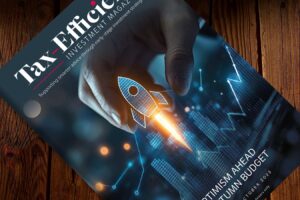As advisers sew up the busy last few days of the 2022/23 tax year, there is a long list of tax considerations – be it frozen or reduced thresholds and allowances, or relaxations around how much can be saved in a pension – which will affect different clients in different ways from 6th April onwards.
In this useful summary, Aegon’s Pensions Director Steven Cameron (pictured) sets out some of the key tax changes, what to look out for and some tips to boost ‘new tax year’ finances.
Income tax thresholds – cuts and freezes
“In the November Budget, the Chancellor confirmed the income tax bands which determine the rate of income tax people pay would be frozen, now until April 2028, which means they are not increasing in line with inflation. In addition, the threshold above which people pay the additional rate of income tax is being reduced from £150,000 to £125,140.
“Freezing the starting point for paying basic rate and higher rate income tax, rather than increasing these in line with inflation, means that as someone’s pay rises they will ‘by stealth’ be paying tax on a larger proportion of their earnings. Some individuals will find they start paying tax for the first time or move into the higher rate tax band, which starts at £50,271,1 or cross the lowered threshold into paying additional rate income tax.
“For many people right now, times are particularly tight. But if you can afford to, one way round paying a higher rate of tax is to pay more into your pension so that your earnings after your pension contributions drop from a little above to just below the higher rate or additional rate threshold. The best way to do this is usually to increase your personal regular pension contributions rather than paying in a lump sum. The precise details depend on the way your pension operates tax relief.
“Those earning between £125,140 and £150,000 in the 2023/24 tax year will find they are subject to additional rate tax for the first time. For them, pension contributions can attract 45%1 tax relief meaning every £1000 paid in costs just £550 from their take home pay.”
The pensions ‘Lifetime Allowance’
“The March Budget included a range of relaxations on how much can be paid into pensions, aiming to encourage people to stay in employment, or return to work, in their late 50s and beyond.
“The lifetime allowance, the maximum you can build up in your pension, is being completely abolished from April 2024. But from 6th April 2023, the ‘penalty’ for exceeding the current limit of £1,073,100 is being removed. Before the change, any ‘excess’ taken as cash was taxed at 55%. But from 6 April, individuals will be taxed on what they withdraw at their highest marginal rate, which will always be less than 55%. This means anyone who feared reaching the lifetime allowance may want to think again, possibly restarting contributions to their pension, but because of many complexities, we recommend first speaking to a professional financial adviser.
“While there will in future be no maximum on how much individuals can build up in their pension (unless a future Government reintroduces one), the amount which can be taken as a tax-free lump sum will remain subject to limits. For most people, this will be 25% of their fund up to a maximum of 25% of the old lifetime allowance of £1,073,100, which works out at £268,275. If you have previously applied for special protections, you may remain entitled to more – the rules are very complex, so check with an adviser.”
The pensions ‘Annual Allowance’
“Previously alongside the Lifetime Allowance there was a limit on how much you and your employer combined could pay into a pension. This Annual Allowance was previously £40,000. But from 6th April 2023, this is increasing to £60,000. This is not likely to affect many people, but some NHS doctors were facing large tax bills because the monetary value of a year’s extra ‘defined benefit’ pension could take them above the old limit. The Government is hoping that the change will mean NHS doctors and others affected will no longer feel pushed into retiring early to avoid facing a large tax bill.
“Those earning above £200,000 and whose ‘adjusted income’ (which includes employer pension contributions) is above £260,000 (rather than the current £240,000) have a lower ‘tapered annual allowance’ which gradually falls to £10,000 (the minimum was previously £4,000) once adjusted income exceeds £360,000.”
Money Purchase Annual Allowance
“The changes to the Lifetime and Annual Allowance will be of most benefit to those on higher incomes or in very generous pension schemes. However, the 6th April 2023 increase in the Money Purchase Annual Allowance from £4,000 to £10,000 will offer wider benefits to more people.
“Individuals can currently access their defined contribution pension flexibly from age 55. But if they do so, the contributions they and their employer can then pay in future are limited to the Money Purchase Annual Allowance. When it was limited to £4,000 it could mean someone who had dipped into their pension to help them through the pandemic or cost-of-living crisis might be unable to take full advantage of an employer’s pension contribution, as paying above £4,000 would have led to a tax charge. This might have discouraged some over 55s from returning to employment. The increase to £10,000 will make this far less likely.
“If you found you were limited in this way, speak to your employer to see if you can restart contributions from you and your employer into your workplace pension.”
State Pension triple lock
“Those receiving State Pensions are in for a double-digit boost from 6th April 2023. Under the triple lock, they will receive an increase of 10.1% which means those entitled to the full new State Pension will see the yearly amount rise from £9,628 to £10,600. Those on the full old state pension get the same % increase taking them from £7,376 to £8,122 a year.
“While this is the highest increase ever in the state pension, it is still just a fraction below current inflation of 10.4%.
“One thing to look out for is that because the threshold for paying income tax has been frozen at £12,570, the full new state pension is now not far behind. Some state pensioners with a modest income, perhaps from a private or workplace pension, may find they are now subject to tax on the amount their total income exceeds £12,570 which will be deducted from their private income.”
Capital Gains Tax (CGT) and Dividend Taxes
“When you sell most types of investments, including second homes, that are not held in pensions or ISAs, the ‘gain’ you make can be subject to Capital Gains Tax (the rate remains at 10% for basic rate taxpayers and 20% for higher rate, with an extra 8% for residential property). From April 2023, the amount of gain in a year which is ‘exempt’ falls from £12,600 to £6,000. From April 2024 it is due to fall further to £3,000. This will mean more people will potentially pay more in CGT. If you are in no pressing need for the proceeds, you may want to take advice on how best to spread your gains over different tax years.
“Similarly, dividends from investments outside pensions and ISAs are subject to income tax. The amount you can receive here each year before being subject to this tax is reducing on 6th April 2023 from £2,000 to £1,000 and then to £500 for the tax year starting 6 April 2024. The rate is staying as is (8.75% for basic rate taxpayers, 33.75% for higher rate taxpayers and 39.35% for additional rate taxpayers).
“Because of the frozen or reduced income tax band thresholds, more people will become subject to higher rates of income tax and hence both CGT and income tax on dividends.
“However, if you are investing through ISAs or pensions, any gains you make when you cash these in are not counted for CGT purposes and dividends from underlying investments are also free of tax. The reduced exemptions mean it may make sense to use up to your £20,000 ISA allowance each year rather than investing directly. And if you are comfortable locking your money away until age 55 (to increase to 57 in 2028) then it’s also worth considering paying more into your pension. The relaxations around paying into pensions may help here too.”
Notes
- There are different thresholds and tax rates in Scotland. For example, the higher rate band starts at £43,663 and the additional rate of income tax is 47%.






![[uns] house of commons, parliament](https://ifamagazine.com/wp-content/uploads/wordpress-popular-posts/788873-featured-300x200.webp)

![[UNS] tax](https://ifamagazine.com/wp-content/uploads/wordpress-popular-posts/788955-featured-300x200.webp)





